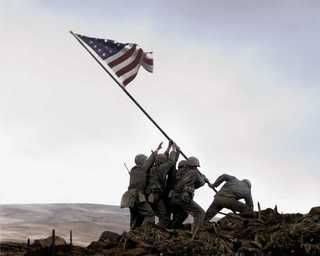
On the fifth day of battle of Iwo Jima, six men were ordered to hoist a larger flag on the island’s highest point to declare that the island had been captured from the Japanese. However, the battle would still rage on for 31 days and cost 26,000 American lives were lost. As the men were raising the flag, Joe Rosenthal, a photographer for the Associated Press, took his lucky shot, which 17 hours later was picked up by publications in the United States. The image later won the Pulitzer Prize for photojournalism, but not without allegations that the scene had been staged.
The irony, however, lies in the tragic fates of the men who had somehow embodied the heroism and victory that their increasingly war-weary country was seeking. A few days after the flag was raised atop Suribachi, three of the six men–Michael Stark, Harlon Block and Franklin Sousley– lost their lives to sniper bullets and friendly fire. The three survivors–Ira Hayes, Rene Gagnon and John Bradley–on the other hand, were shipped back to the United States to help sell bonds across the country. In the course of touring the America's major cities, they are confronted with survivor’s guilt over the death of their comrades and being called heroes by the adoring public when they felt that they didn’t deserve such regard. The controversy over the identity of the sixth man in the photograph who was at first thought to be Hank Hansen did not help the soldiers either, particularly Hayes, who eventually revealed that the man in question was in fact Block.
The film does not romanticize heroism but adopts a no-holds-barred depiction of the brutality of war–decapitations, lost lives, someone losing his head quite literally and enemies blowing themselves up over the prospect of falling as prisoners in the hands of their enemies. And while a single photograph was able to capture a nation’s pride and catapulted its subjects to fame, the public which never witnessed war’s gruesome scenes first-hand easily lost interest in the people it had once put on the pedestal…or left cold upon a pedestal. Hayes, a native American, had it worst among the three survivors due in part to his race. Apart from suffering alcoholism and poverty, he took frequent jail trips in the course of his short life, which ended in a questionable manner. Gagnon found it difficult to even hold a steady job when his celebrity had worn off. Only John Bradley, whose son would write the book on which the film was based, lived comfortably with his family for the rest of his life. He never talked about his involvement in the battle of Iwo Jima nor about his purple heart, which his son discovered after his death. The brutal demise of his best friend, Ralph “Iggy” Ignatowski, haunted him through old age.
“Flags” is another Steven Spielberg production that depicts World War II and looks like an extension–or a Pacific Theater rejoinder–to Saving Private Ryan and the mini-series, Band of Brothers. Moreover, it even looks like a reunion of sorts for some of the actors who figured in “Ryan” and “Brothers,” such as Barry Pepper who played the religious sniper in Saving Private Ryan and Neal McDonough who played Lt. Lynn Compton in Band of Brothers. They played Michael Strank and Capt. Dave Severance, respectively, in this movie.
I had a hard time digesting the flashbacks interspersed with tour scenes and interviews with the parties involved in promoting the bond drive. And while some critics declare that the film is Clint Eastwood’s take on the Iraq war, this is better seen as a lesson on how heroes are either made or unmade with media’s compliance. But more to the point, it paints a sad picture of how heroes had been discarded by the public which they sought to protect in the first place. At the end of the day, it seemed that the real heroes were those whose lives were lost in the battlefield. The ones who lived were merely survivors.
No comments:
Post a Comment